When kids start taking music lessons or even just wishing they could play a musical instrument, one of the first things we (or they if they’re old enough!) do is start looking for sheet music for kids.
The problem is, sheet music can look scary. Even like it’s a different language. But, by using a few tips and tricks you can help your child begin to interpret it!
If you read through to the end, I’ve also given you a list of good places to find free sheet music for kids online!

Choose the right sheet music
My first, and maybe most important, trick to reading sheet music for kids is to choose the right sheet music.
It’s so easy to find the perfect song your child loves, and think they’ll have a great time playing it. But… if they don’t already know their way around their instrument and know how to read music, tread carefully. You might just get them discouraged or frustrated! And that’s not what any of want!
Choose Easier Sheet Music
The answer is to not get overexcited. If your child doesn’t know how to read sheet music that’s just fine – that’s what this article is here to help you with after all!
But, if that’s the case, let’s choose something easy to get started with. Look for music labelled beginner, primer, or for young children (even if your child is older).
If it’s piano sheet music you’re looking for, my Guide to Kids’ Piano Sheet Music will help you choose just the right level of sheet music for your kids.
Easy sheet music isn’t a bad thing. In fact, easier is better when it comes to learning to read sheet music for kids!
Choose Sheet Music for the right Instrument
The second tip to choosing the right sheet music, is to choose music for the instrument your child plays. If your child plays the recorder, you don’t want to give them guitar music, and likewise in reverse. This sounds obvious, but it can be important. Some sheet music can be played by different instruments, but do double check your child’s instrument can plays the music before you give it to them.
Note values
Once you have the right sheet music for your kids, the next tip is to recognize the note values.
Note values are represented visually. Each note value represents a different length of time to hold the note. For example, a note that receives 2 beats should be held twice as long as a note that gets 1 beat.
The most common note values in sheet music for kids are the quarter note, the half note, the dotted half note, and the whole note. Use the image below to learn the note values for each of the most common notes.
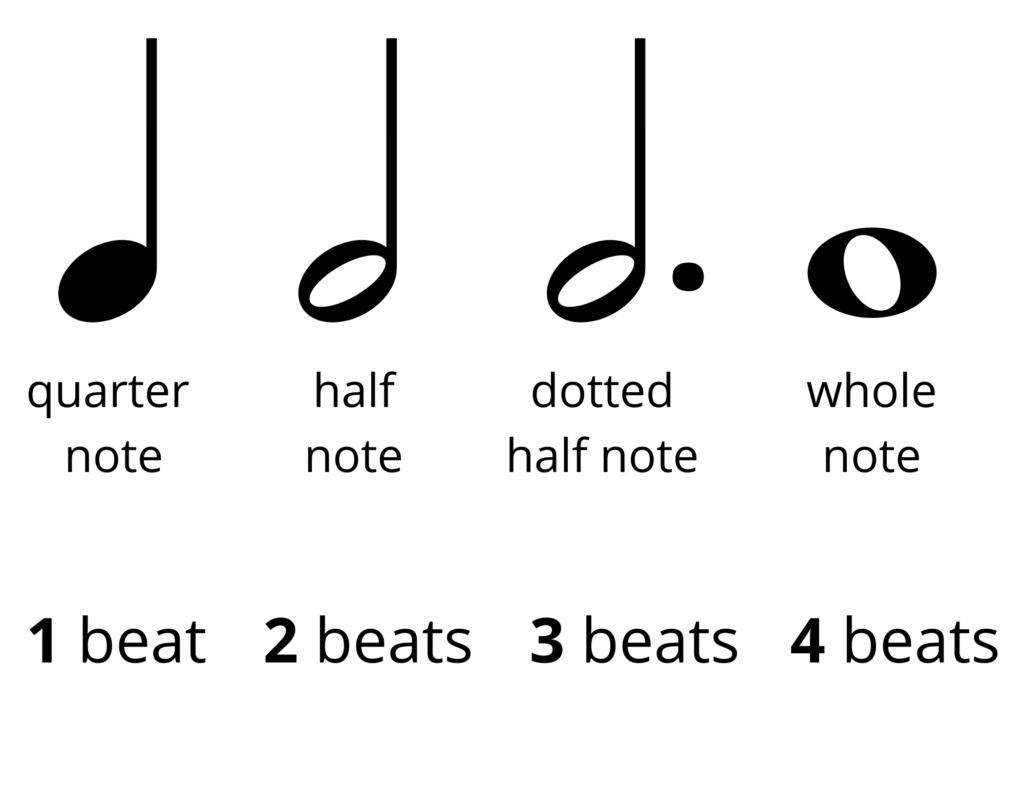
Clefs
Let’s get onto actually reading the sheet music now! The first thing to notice is the clefs. The clef is written at the very beginning of the music staff. There are two clefs used most often: the treble clef for higher pitches, and the bass clef for lower pitches.
The piano uses both the treble and the bass clefs. Many other instruments use just one of the clefs. For example, the flute, violin, and recorder use the treble clef only. If their instrument only uses one clef, your kids can learn the tricks to read just those notes for now.
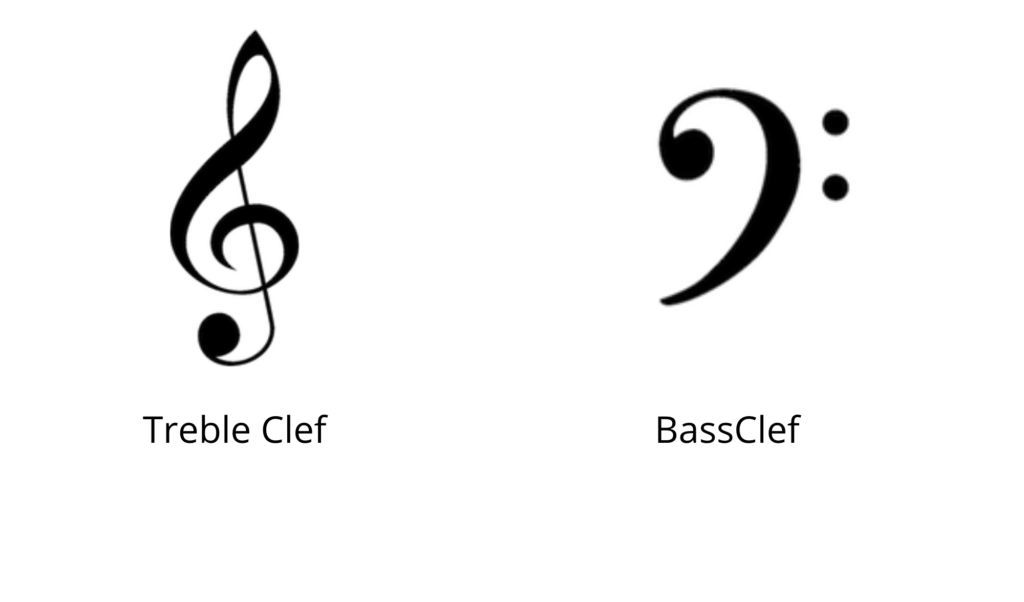
The lines and the spaces
The clefs and the notes are placed on the music staff. The staff consists of 5 lines and 4 spaces. Notes are on a line if the line goes through their middle.
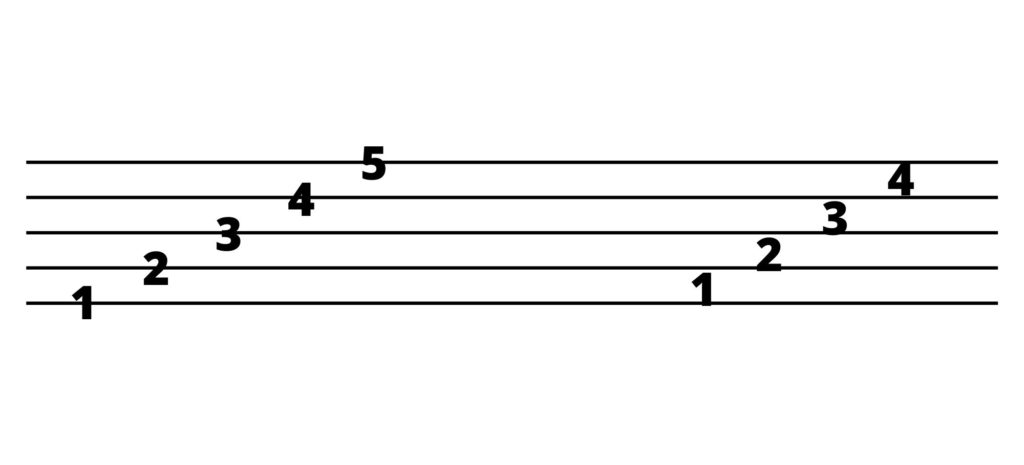
Note names
The next tip for reading sheet music for kids is to help them recognize the note names quickly.
The simplest way to remember notes’ names is with mnemonics. You may be familiar with some of these, or similar ones if you ever took music classes in school.
In the treble clef the spaces spell face. “FACE in the space” is a good way to remember these notes.
In the lines on the treble clef, remember that “Every, Good, Boy, Deserves, Fudge”. Some kids might find the mnemonics easier to remember if they create their own saying instead.

In the bass clef, the spaces are “All, Cow, Eat Granola, Bars”. The lines in the bass clef are “Good, Boys, Deserve Fudge Always”.
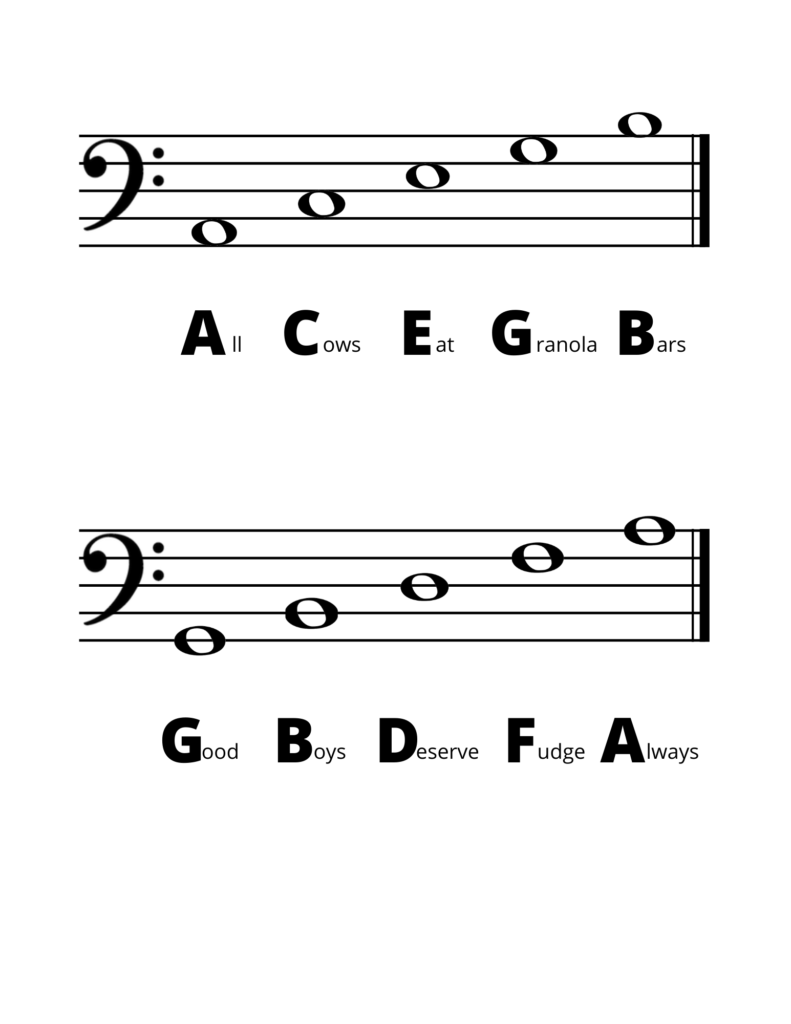
These tricks give kids an easy way to remember the note names before they’re able to recognize them by memory. And even once you have a confident reader, every once in a while we all draw a blank, and need a trick to help our brains remember!
If your child plays the piano or would like to read music on the grand staff (both the treble and bass clefs), check out the printable activity cards for young children in How to Read Music for Beginners.
Should you write the note names into sheet music for kids?
This is a common question when kids are just getting started reading sheet music. It seems like writing in the note names would be a great trick to help them learn faster. And, as much as the teacher part of me cringes to say, it might be a useful trick. BUT, that depends a lot on the goal.
Writing each note in will make the sheet music easier in the short term, but prevents your child from learning to read music on their own as quickly in long term. So, if your child wants to play one piece of sheet music quickly, you might write the notes in. But if they would like to learn how to play any sheet music they like in the future, it’s best to limit writing in notes to (at most) the first note in the piece, or perhaps an especially tricky one once in a while.
Patterns
This tip will make reading music even faster! This might seem contrary to the last tip, but encourage your kids not to identify each note as they play.
Looking for patterns in the music will speed up playing. Much like we don’t read individual letters in a sentence once we get going, but words and common patterns. Music is the same.
It’s important to be able to recognize the note names to get started and unstuck here and there. But, to become confident at reading sheet music for kids, they will have to look for patterns. It will make playing the music much easier!
The first patterns to notice are whether the notes move higher or lower on the music staff.
Many notes move by step, or to the very closest note up or down on the music staff.
Steps move from a line to the very next space, or a space to the very next line. Steps ‘step’ to the very next note. For example, from the note B, to the note C would be a step up. From the note C to the note B would be a step down. On the piano a step is the very closest key (white key to white key) up or down.

Some notes move by a skip instead. Notes moving by skip will move from a line to the very closest line (skipping the space in between). Or from a space to the very closest space (skipping the line in between).
For example, a skip up would go from A to C (skipping over the note B). A skip down would go from C to A.

As kids read more music, they will begin to easily recognize that notes are moving up or down, and by step, skip, or a larger interval (distance). As this happens, they won’t need to stop and work through a mnemonic to identify each and every note.
Look for similarities
The easiest tip to simplify reading sheet music for kids, is to look for repeated or similar parts of the music.
Most sheet music will have parts that are the same as each other. This happens even more if they’re playing music that has words and a chorus. The words change, but usually, the music stays the same and is just written out again on the page.
Without noticing this, the length of sheet music might make it seem much scarier or more difficult than it really is. Without noticing these parts beforehand, kids might struggle through the music that they could otherwise readily play.
Recognizing that you’ve already learned how to play the last two lines just because you played the first two, is a big confidence booster for kids.

Practice
Possibly the most effective tip to reading sheet music for kids is to practice! Like anything else, the more they do it, the easier it will become.
The best way to practice reading sheet music for kids isn’t to choose a challenging piece and spend hours and weeks practicing that piece. The best way to improve at reading sheet music is to play lots of sheet music that is easy for them.
Lots of experience reading the music will help kids start to recognize common notes and patterns in the music faster, than only playing one piece of sheet music that is much more challenging.
Summary of the steps to read sheet music for kids:
- Choose sheet music that is appropriate for your child’s level and instrument.
- Recognize clefs, note values, and note names.
- Look for similar sections in the music.
- Recognize the first note
- Look for patterns before you start playing. For example, does the sheet music start with step. Does it start with notes moving up or down?
- Read by patterns rather than note names once you get going
- Choose a short section to learn at one time. Some sheet music, especially pop, is really long. Learning a very long piece of music all at once can be very unmotivating and inefficient.
- Practice – read lots of sheet music.
Where to find sheet music for free:
Sheet music for kids is widely available for free online. Check out some of the sites below, which all have big libraries of free sheet music for kids organized by level. Many of these sites have sheet music for multiple different instruments, so be sure to browse around if you’re looking for something specific.
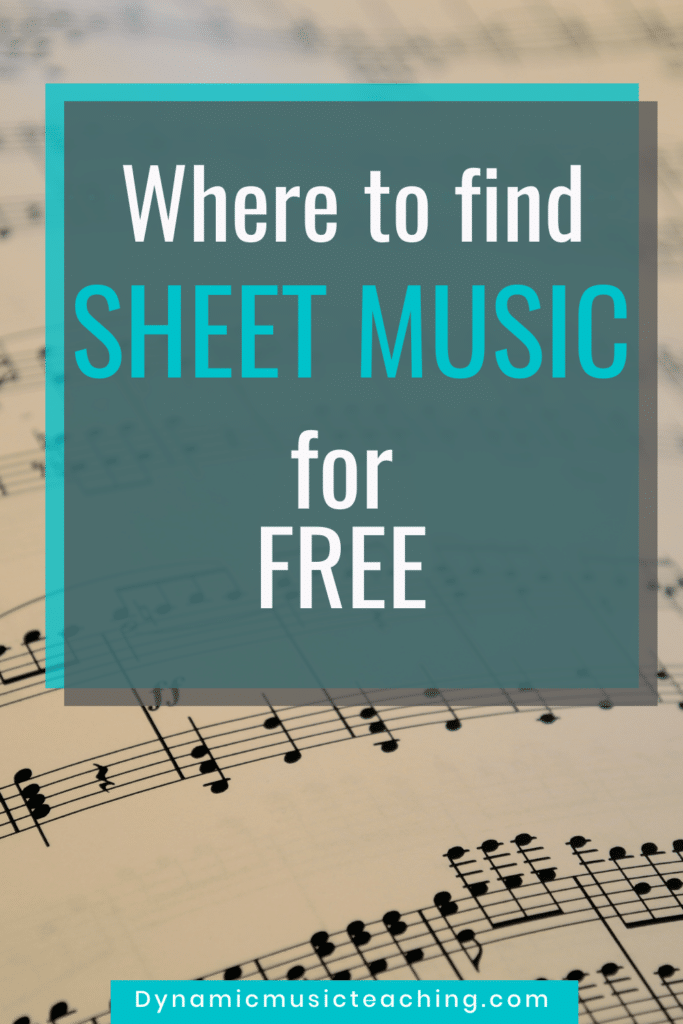
- G Major Music Theory
- Piano Song Download (piano)
- Violin Sheet Music (violin)
- Music for Music Teachers
- Making Music Fun
- Capotasto Music (recorder and much more)
One caveat to free sheet music for kids is that it’s not available for Pop music or current hits. This is because these songs are still under copyright, and it is illegal to post them for free. So while there is lots and lots of free sheet music out there for your kids, if they desperately want to learn the latest Disney hit or a pop song, you might have to pay a couple of dollars.
This post may contain affiliate links, which means I receive a small commission, at no extra cost to you, if you make a purchase using the link. See the full disclosure for more information.
The best resources for this kind of sheet music for kids are:
- Sheet Music Plus (sheet music & music books)
- Download Sheet Music at Musicnotes.com
- Check out my Guide to Kids Piano Sheet Music for more tips if your child is playing the piano!
What sheet music is your child playing?
I hope these tips for reading sheet music for kids have helped! I’d love to hear what music your kids are playing. Are they just getting started with an instrument, or have they been playing for a while?
If you need any more tips or have questions, feel free to ask. I’d be happy to help!
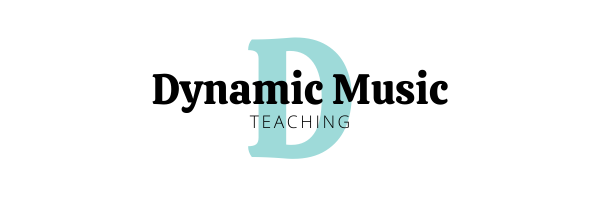
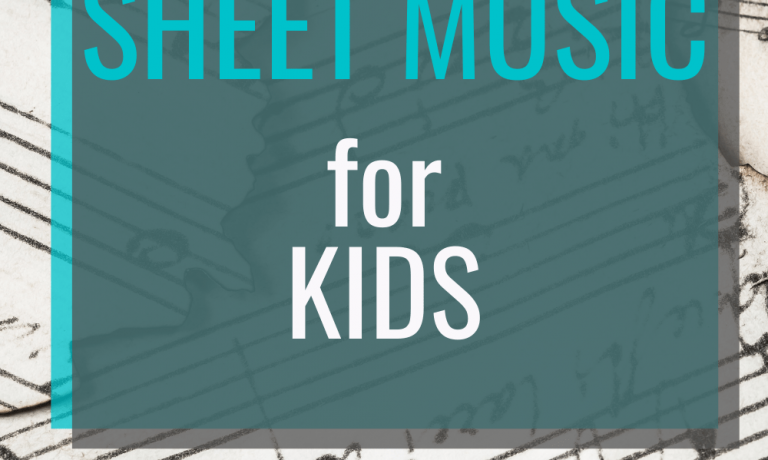


6 Responses
Hi Katharine!
Thank you so much for your info and help online. My grandson is a very small ten year old that has his heart set on learning the violin. I would like to know if we should be studying notes/sheet music for the summer. He will be joining 5th grade band class next year. How exciting! But since he is such a shy guy, I am hopeful in doing what is best for him while we wait for that class to begin. Do you have any suggestions?
Thank you for your time,
Sheila
Hi Sheila,
Thanks so much for reading! That is wonderful that your grandson wants to learn the violin and has the opportunity to join the school band next year! Band class will definitely teach him to read music, but getting acquainted with the notes on the staff ahead of time will give him a head start and give him an extra boost of confidence.
The violin used the treble clef, so that would be the place for him to start. He can learn the ‘rhymes’ to remember the notes on the treble clef (FACE in the spaces & Every, Good Boy Deserves Fudge for the lines). To practice there are good apps such as ‘Staff Wars’ or many others depending on your device.
There are also many free note naming worksheets and printable flashcards available online if you prefer a screen free option. I have a small number of free resources (I’m adding as time allows), but you could want to check out the site ‘Making Music Fun’ for some relevant treble clef note name worksheets.
If your grandson watches YouTube, he could also check out the channel ‘Music with Meg’. She has excellent violin centered videos that introduce kids to the instrument, as well as well as music theory topics such as rhythm and notes. Her videos would be a well suited introduction to music and the violin for someone your grandson’s age.
I hope this helps, please let me know if I can give you any more suggestions! All the best to you and your grandson,
Katharine
I’m an adult learning to read sheet music for the first time. I have been pencilling the note name under each note. Is this normal? Is it hindering me from learning to sight read? Should I stop, or reduce.I can’t find guidance online…
That’s a great question! Yes, it is quite normal for beginning readers to do this, but also yes it will hinder you from learning to sight read. In the short term, writing in each note may let you feel as if you can play harder music faster, but in the long run you will prevent yourself from learning to read the music itself. My advice to learn to read music well is to read lots of it! Find a bunch of music that is quite easy, and (without writing in the notes) play through some of it each time you sit down to practice. The more new music you play through (again choose quite easy music for this) the faster you will become able to recognize notes without stopping to figure each one out. It doesn’t mean you can’t try something a bit more challenging as well or write in one note you keep playing wrong of course. Let me know if that is helpful. Take care, Katharine
What is the note when it’s under all the lines
Hi there,
The note that is directly below the staff in the treble clef is D (if it has a small line through it and is below the treble staff it is C).
The note that is directly below the staff in the bass clef is F.
There are many other notes below the staff that will have one or more small ‘ledger lines’. You can figure these out by counting the music alphabet (a, b, c, d, e, f, g, a, b, etc.) backward from a note on the staff that you know – down each line and space below the staff until you arrive at your note.
I hope that helps!
Katharine